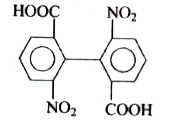Which one of the following is expected to exhibit optical isomerism (en=ethylenediamine)?
Cis−[Pt(NH3)2Cl2]
Trans−[Co(en)2Cl2]+
Trans−[Pt(NH3)2Cl2]
Cis−[Co(en)2Cl2]+
The correct Answer is:D
To determine which of the given compounds exhibits optical isomerism, we need to analyze the structures of each compound and check for the presence of chiral centers. A compound exhibits optical isomerism if it has non-superimposable mirror images, known as enantiomers.
1. Understand Optical Isomerism:
Optical isomerism occurs when a compound can exist in two forms that are mirror images of each other but cannot be superimposed. These forms are called enantiomers.
2. Identify the Compounds:
We need to analyze the four options provided. The central metal ion in each compound will be surrounded by ligands, and we need to determine their spatial arrangement.
3. Analyze Option A:
- The structure involves a metal (let's say Pt) with ligands arranged in a certain way.
- After drawing the structure and its mirror image, we find that the two images can be superimposed.
- Conclusion: This compound does not exhibit optical isomerism.
4. Analyze Option B:
- This compound has a cobalt center with ligands arranged in a trans configuration.
- Drawing the structure and its mirror image shows that they can be superimposed.
- Conclusion: This compound does not exhibit optical isomerism.
5. Analyze Option C:
- Similar to Option B, this compound has a trans configuration.
- Again, upon drawing the structure and its mirror image, we find that they can be superimposed.
- Conclusion: This compound does not exhibit optical isomerism.
6. Analyze Option D:
- This compound has a cis configuration with one chlorine atom above the plane and another in the plane, while the ethylenediamine ligands are positioned differently.
- Upon drawing the structure and its mirror image, we find that the two images cannot be superimposed.
- Conclusion: This compound exhibits optical isomerism.
7. Final Answer:
- The compound that exhibits optical isomerism is Option D: cis-(Co(en)₂Cl₂).
Optical isomerism occurs when a compound can exist in two forms that are mirror images of each other but cannot be superimposed. These forms are called enantiomers.
We need to analyze the four options provided. The central metal ion in each compound will be surrounded by ligands, and we need to determine their spatial arrangement.
- The structure involves a metal (let's say Pt) with ligands arranged in a certain way.
- After drawing the structure and its mirror image, we find that the two images can be superimposed.
- Conclusion: This compound does not exhibit optical isomerism.
- This compound has a cobalt center with ligands arranged in a trans configuration.
- Drawing the structure and its mirror image shows that they can be superimposed.
- Conclusion: This compound does not exhibit optical isomerism.
- Similar to Option B, this compound has a trans configuration.
- Again, upon drawing the structure and its mirror image, we find that they can be superimposed.
- Conclusion: This compound does not exhibit optical isomerism.
- This compound has a cis configuration with one chlorine atom above the plane and another in the plane, while the ethylenediamine ligands are positioned differently.
- Upon drawing the structure and its mirror image, we find that the two images cannot be superimposed.
- Conclusion: This compound exhibits optical isomerism.
- The compound that exhibits optical isomerism is Option D: cis-(Co(en)₂Cl₂).
Similar Questions
Knowledge Check
Which of the following acids does not exhibit optical isomerism?
AMaleic acidBα-amino acidsCLactic acidDTartaric acidWhich of the following compounds exhibit optical isomerism?
A BH2C=C=CH2C
BH2C=C=CH2C D
D
Which of the following compounds can exhibit geometrical isomerism?
AH3C−CH2−CH=CH−CH3B C
C D
D
Out of the following the alkene that exhibits optical isomerism is
View SolutionWhich of the following compound will exhibit geometrical isomerism ?
View SolutionWhich of the following complex species is not expected to exhibit optical isomerism ?
View SolutionWhich of the following compounds will exhibit geometrical isomerism?
View SolutionWhich of the following complex species is not expected to exhibit optical isomerism ?
View Solution